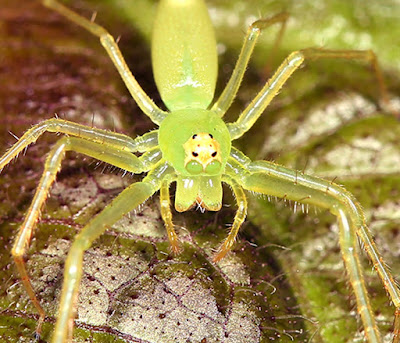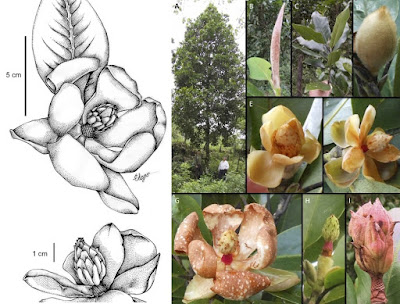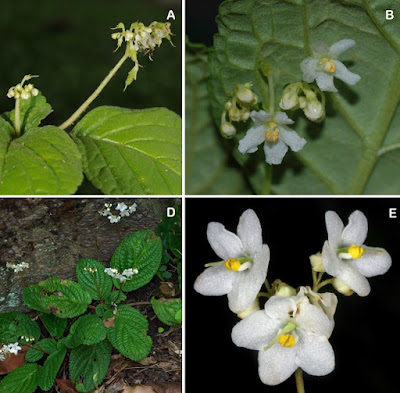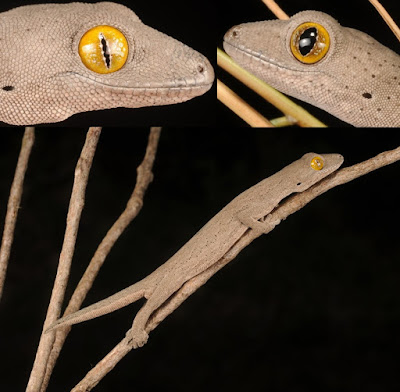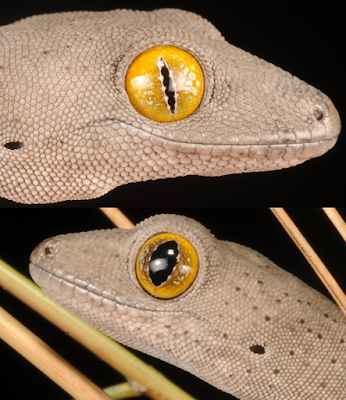[Most Recent Entries] [Calendar View]
Saturday, November 18th, 2017
| Time | Event | ||||
| 5:04a | [Arachnida • 2017] Revision of Hindumanes Logunov, 2004 (Araneae: Salticidae: Lyssomaninae), with Description of A New Species, H. wayanadensis, from the Western Ghats of Kerala, India
Abstract The monotypic genus Hindumanes Logunov, 2004 is revised. We present fresh specimens of Hindumanes karnatakaensis (Tikader & Biswas, 1978), the type species, and describe Hindumanes wayanadensis sp. nov. from the Wayanad Wildlife Sanctuary, a part of the Western Ghats, Kerala, India. This paper provides the first description of the male of H. karnatakaensis and a redescription of its female. We also transfer the genus from Asemoneinae Maddison, 2015 to Lyssomaninae Blackwall, 1877. The relationship between Hindumanes and Lyssomanes Hentz, 1845 and the zoogeography of the subfamily are discussed. The distribution records of the genus are mapped. Keywords: Araneae, long-legged jumping spider, subfamily placement, zoogeography, relict, Wayanad Wildlife Sanctuary, biodiversity hotspot Puthoor Pattammal Sudhin, Karunnappilli Shamsudheen Nafin and Ambalaparambil Vasu Sudhikumar. 2017. Revision of Hindumanes Logunov, 2004 (Araneae: Salticidae: Lyssomaninae), with description of a new species from the Western Ghats of Kerala, India. Zootaxa. 4350(2); 317–330. DOI: 10.11646/zootaxa.4350.2.7 | ||||
| 8:54a | [Botany • 2017] Magnolia montebelloensis • A New Species in Section Magnolia from Lagunas de Montebello National Park, Chiapas, México, with A Key to Magnoliaceae of Chiapas
Abstract A new species of Magnolia, from the Lagunas de Montebello National Park, in the central highlands of Chiapas, Mexico, is described and illustrated. Magnolia montebelloensis belongs to section Magnolia; it differs from M. poasana in its smaller habit, densely pubescent terminal twig internodes, stipules and spathaceous bracts, shorter peduncular internodes and more numerous stamens. A key, an ecological and a conservation assessment of the eight Chiapan species of Magnoliaceae are included. Magnolia montebelloensis grows in montane rain forest and is contrasted with other Chiapan Magnolia species regarding their climate and vegetation preferences. It was assessed as critically endangered (CR) according to IUCN B1ab(ii,iii) and B2ab(iii) criteria. Half of Magnolia species in Chiapas occur in protected natural areas, and thus immediate action is required to protect the other four species, M. faustinomirandae, M. mayae, M. sharpii and M. zamudioi. Seven out of the eight Magnolia species (88%) are not found in ex-situ collections despite being endangered or critically endangered. Keywords: Magnolia guatemalensis, Magnolia hondurensis, Magnolia poasana, “Tajchack” (Tzeltal language), Magnoliids Magnolia montebelloensis A.Vázquez & Pérez-Farr., sp. nov. Eponymy:—This species is named after the Lagunas de Montebello National Park, the type locality. J. Antonio Vázquez-García, Miguel Ángel Pérez-Farrera, Héctor Gómez-Domínguez, Miguel Ángel Muñiz-Castro and Eduardo Sahagún-Godínez. 2017. Magnolia montebelloensis, A New Species in Section Magnolia from Lagunas de Montebello National Park, Chiapas, México, with a key to Magnoliaceae of Chiapas. Phytotaxa. 328(2); 101-114. DOI: 10.11646/phytotaxa.328.2.1 | ||||
| 2:56p | [Botany • 2017] A Revision of Middletonia (Gesneriaceae) in Thailand
ABSTRACT The genus Middletonia in Thailand is revised. We recognise four species, including the newly described Middletonia glebosa C.Puglisi and the resurrected M. reticulata (Barnett) C.Puglisi. A key to the species, full descriptions and proposed conservation assessments are provided. KEYWORDS: taxonomy, new species, Flora of Thailand MIDDLETONIA C.Puglisi, Taxon. 65: 286. 2016. Type species: Middletonia multiflora (R.Br.) C.Puglisi. Five species, found in India, Bangladesh, Bhutan, Myanmar, China, Thailand, Laos, Cambodia, Vietnam and Malaysia. Four in Thailand. 1. Middletonia evrardii (Pellegr.) C.Puglisi, Taxon. 65: 286. 2016 Distribution.— Lao PDR, Vietnam. Thailand.— EASTERN: Nakhon Ratchasima, CENTRAL: Nakhon Nayok Ecology.— Evergreen forest. Note.— The material from Thailand differs slightly from the Vietnamese material, especially in the leaf shape which is more elongated and with an acute apex in the Thai specimens. As there are rather few specimens from throughout the distribution range, with no floral material from Thailand available for dissection, further collections are necessary to assess whether the Thai and Vietnamese plants belong to one or more species. 2. Middletonia glebosa C.Puglisi, sp. nov. Similar to Middletonia regularis in having the inflorescences shorter than the leaves and to Middletonia reticulata in the shortly caulescent habit. Differs from both in having a dense indumentum on the adaxial side of the leaf, with glands and eglandular hispid hairs (upperleafsurface glabrescent or minutely glandular in Middletonia regularis, glabrescent in M. reticulata), and in the short, non-twisted, lumpy and irregular fruit (longer, weakly to strongly twisted, smooth and regular in M. regularis and M. reticulata). Type: Thailand, Sukhothai, Ram Kham Haeng National Park, Khao Luang, alt. 520 m, 11 Oct. 2012, fr., Middleton, Karaket, Suddee & Triboun 5559 (holotype E [E00547434]; isotypes BK, BKF [SN201922]). Distribution.— Cambodia. Thailand.— NORTHERN: Sukhothai. Ecology.— Mixed deciduous forest with bamboo on granite bedrock. Etymology.— The specific epithet is the Latin adjective glebosus, -a, -um, which means “lumpy” and refers to the peculiar surface of the capsule. Notes.— In Ram Kham Haeng National Park this species grows in a mixed population with Middletonia reticulata. The two are readily told apart in the field by Middletonia glebosa having softer, paler leaves, a shorter inflorescence, generally slightly smaller flowers, and the curious short, straight, lumpy fruit. The species is known only from Ram Kham Haeng National Park and a single collection made around 150 years ago in Cambodia. The Cambodian collection, placed in Paraboea regularis by Xu et al. (2008), is only in fruit so the identification will need to be verified with flowering material. However, the fruit of this species is rather distinctive. 3. Middletonia regularis (Ridl.) C.Puglisi, Taxon. 65: 287. 2016. Distribution.— Malaysia. Thailand.— PENINSULA: Surat Thani, Phangnga; SOUTH-WESTERN: Kanchanaburi. Ecology.— Lowland evergreen forest on limestone soils. Note.— The protologue of Paraboea monticolasuggests the flowers to be much larger: “lobes … 6–9 × c. 6.5 mm”. However, none of the material available for this study had lobes longer than 3.3 mm. 4. Middletonia reticulata (Barnett) C.Puglisi, comb. nov. — Boea reticulata Barnett, Nat. Hist. Bull. Siam Soc. 20: 20. 1961. Type: Thailand, Chiang Mai, Mae WangEcology.— Mixed deciduous forest on granite bedrock. Distribution.— Currently endemic to Thailand but possibly also occurring in Lao PDR and Myanmar. Thailand.— NORTHERN: Mae Hong Son; Chiang Mai; Lamphun; Lampang; Phrae; Sukhothai. Note.— This species is resurrected from synonymy of Middletonia multiflora (R.Br.) C.Puglisi from which it differs in the distinctively reticulate venation pattern covered in loose brown indumentum on the lower surface of the leaves, and in the auriculate leaf base. Middletonia multiflora has a denser indumentum on the leaf and the tertiary venation is less densely reticulate and less visible altogether. Middletonia multiflora is widespread along the northern distribution of the genus (from India to Vietnam), but none of the material from Thailand studied can be attributed to M. multiflora. Carmen Puglisi and David J. Middleton. 2017. A Revision of Middletonia (Gesneriaceae) in Thailand. THAI FOREST BULL., BOT. 45(1); 35–41. DOI: 10.20531/tfb.2017.45.1.07 | ||||
| 5:12p | [Mammalogy • 2017] Ototylomys chiapensis • A New Species of Big-eared Climbing Rat, Genus Ototylomys (Cricetidae: Tylomyinae), from Chiapas, Mexico
Abstract An allopatric population of big-eared climbing rats (Ototylomys) from the Northern Highlands of Chiapas, Mexico, is described as a new species. The new taxon is part of a unique montane rainforest community that includes several other endemic species in the limited geographic range between the Río Grijalva and the Central Depression of Chiapas. Several cranial, external, and molecular characters distinguish this new species of big-eared climbing rat from its more widely distributed congener, Ototylomys phyllotis. We performed principal component and discriminate function analyses of cranial measurements, and found that specimens of the new species consistently could be distinguished from other Ototylomys with strong statistical support. Compared with exemplars of Ototylomys from elsewhere in their range, the new species possesses a karyotype that differs by 3 additional biarmed chromosome pairs, is fixed or nearly fixed for distinct electromorphs at 12 allozyme loci, and the mean genetic distance exceeds 14%, based on comparisons of the mitochondrial cytochrome b gene between the new species of Ototylomys and representatives of O. phyllotis. The restricted distribution in montane karst rainforest suggests that the species and its habitat may be a matter of conservation concern. Taxonomy Family Cricetidae Fischer, 1817 Subfamily Tylomyinae Reig, 1984 Tribe Tylomyini Reig, 1984 Genus Ototylomys Merriam, 1901 Ototylomys chiapensis, new species La Pera Big-eared Climbing Rat; Rata orejuda trepadora de La Pera Ototylomys phyllotis connectens: Baker et al. 1971 [1973]:82 (part, faunal report based on a specimen collected in 1969, here reidentified as O. chiapensis). Ototylomys phyllotis connectens: Hall 1981:629 (part, marginal locality record based on Baker et al. 1971 [1973]). Ototylomys phyllotis: Lawlor 1982:3 (part, karyotypic report based on Engstrom and Tucker, cited as in litt.). Ototylomys sp.: Rogers, Engstrom, and Arellano 2004:439 (allozyme data from 2 specimens included in the present study). Ototylomys sp. nov.: Dudley and Parish 2006:4 (referenced as endemic to El Pozo [= La Pera]).
Etymology: The specific name refers to the species distribution in the Mexican state of Chiapas. Distribution: Known only from the type locality and from 26 km N Ocozocoautla, both in the Mexican state of Chiapas (Figs. 1 and 2). The latter locality is in the municipality of Ocozocoautla de Espinoza at ca. 760 m elevation in the Reserva de la Biosféra Selva El Ocote, and is measured along the “old road” northwest of the city of Ocozocoautla de Espinoza (Johnson et al. 1976; Johnson and Savage 1995; Lamoreux et al. 2015). Calvin A. Porter, Nia E. Beasley, Nicté Ordóñez-Garza, Laramie L. Lindsey, Duke S. Rogers, Nicole Lewis-Rogers, Jack W. Sites, Jr. and Robert D. Bradley. 2017. A New Species of Big-eared Climbing Rat, Genus Ototylomys (Cricetidae: Tylomyinae), from Chiapas, Mexico. Journal of Mammalogy. 98(5); 1310–1329. DOI: 10.1093/jmammal/gyx096 Una población alopátrica de rata orejuda trepadora (Ototylomys) de las Tierras Altas del Norte de Chiapas, México se describe como una nueva especie. El nuevo taxón es parte de una comunidad única de bosque lluvioso montano que incluye varias especies endémicas en el área de distribución geográfica limitada entre el Río Grijalva y la Depresión Central de Chiapas. Varios caracteres craneales, externos, y moleculares distinguen la nueva rata orejuda trepadora de su congénere más ampliamente distribuido, Ototylomys phyllotis. Se realizaron análisis de componentes principales y de función discriminante de los caracteres craneales, y se encontró que los especímenes de La Pera fueron consistentemente distinguidos de otros Ototylomys con un fuerte soporte estadístico. En comparación con ejemplares de Ototylomys del rango, la nueva especie posee un cariotipo que difiere por 3 pares adicionales de cromosomas biarmados, está fijo o casi fijo por distintos electromorfos en 12 loci alozímicos. Adicionalmente, la media de la distancia genética comparada del gen mitochondrial citocromo b entre la nueva especie de Ototylomys y representantes de O. phyllotis, excede el 14%. La distribución restringida en el bosque lluvioso montano kárstico sugiere que la especie y su hábitat pueden ser de importancia para la conservación. New rat species discovered, named at Sternberg https://www.hayspost.com/2017/11/16/new-r | ||||
| 5:14p | [Herpetology • 2017] Strophurus trux • A New Species of Gecko (Squamata: Diplodactylidae: Strophurus) from central Queensland, Australia
Abstract A new species of diplodactylid gecko in the genus Strophurus Fitzinger, from central Queensland, Australia, is described herein as Strophurus trux sp. nov. It is similar to the recently described Strophurus congoo Vanderduys from north Queensland and apparently shares a habitat preference for Triodia hummock open woodlands. It is notably different from the latter in possessing a vivid yellow to golden eye. It is only known from one small area of the Brigalow Belt Bioregion, although it is expected to occur more widely than the one area in which it has been found. It is likely that it is endemic to the Brigalow Belt Bioregion. Keywords: Reptilia, Brigalow Belt, Triodia, Golden-eyed Gecko Strophurus trux sp. nov. Golden-eyed Gecko Etymology. The specific epithet " trux " is Latin for wild, savage, harsh and pitiless, including instruments of human savagery, and also of the scene of such cruelty (Lewis & Short 1879; Glare 1982). This name was Chosen in reference to the only location known for Strophurus trux sp. nov. It is in the proximity of the "Marlborough stretch", a section of the old Bruce Highway in Central Queensland with notoriety as a wild and dangerous place in the 1960s and 1970s because of a series of murders and shootings (Gibson 2002) and its general remoteness.
Eric Vanderduys. 2017. A New Species of Gecko (Squamata: Diplodactylidae: Strophurus) from central Queensland, Australia. Zootaxa. 4347(2); 316–330. DOI: 10.11646/zootaxa.4347.2.7 |
| << Previous Day |
2017/11/18 [Calendar] |
Next Day >> |
